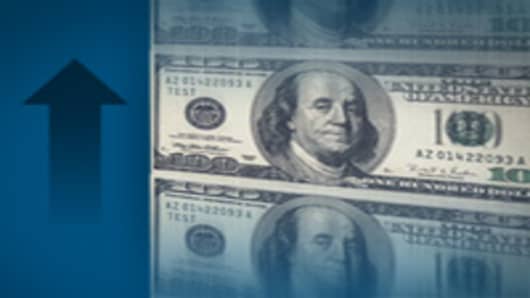As commodity prices keep moving higher and bond buyers slowly head for the exits, investors are starting to give more credence to a looming inflation threat.
Through most of the recovery following the collapse of the financial system, policy makers had spent far more time warning about deflation, even as the Federal Reserve, led by Chairman Ben Bernanke, continued to flood the economy with money.
But growth in emerging markets and in the US—coupled with the trend of rising interest rates—has shifted market dialogue in a different direction. It's also changed investing trends—out of bonds and toward commodities, while stocks, particularly in the energy sector, only increase in popularity.
"What the bond market is sniffing out is higher perceived levels of future inflation," Greg Peters, head of fixed income research at Morgan Stanley, said in a CNBC interview. "While inflation today looks pretty benign, what bond investors don't like right now is the uncertainty factor around the future inflation picture."
Bond prices have fallen in six straight trading sessions, with the consensus view being that traders are reacting to inflation threats observed through the steady climb in commodities.
The benchmark 10-year note yield has gained about a third of a percentage point during that time, rising from 3.36 percent on Jan. 28 to approach 3.70 percent in Monday trading. While the level is far from suggesting serious inflation is on the near horizon, the trend suggests fear is growing.
"If you look at the markets, commodity markets see inflation, bond markets see inflation, and obviously with equities growing, they're inflating," Keith McCullough, CEO of Hedgeye Risk Management, told CNBC. "So I don't see a lot of sustenance to suspending disbelief that Ben Bernanke says there's no inflation."
In a speech last week, the central bank chairman continued to insist that inflation is below a level that would reflect a controlled gain and thus a healthier economy.
The market interpreted the remarks as signaling that the Fed will stick to its zero-interest-rate policyfor the foreseeable future. Bill Gross, managing director at Pimco, figured there would be no rate increases at least until unemployment fell a full point to 8 percent.
"Given that the Fed's implicit target for core inflation is 1.7% to 2.0%, this is unlikely to prompt it to call a premature halt to its current round of purchases or to shut the door firmly on any future purchases," Paul Dales, chief US economist at Capital Economics in Toronto, wrote in a research note for clients. "Indeed, the continued low level of core inflation will mean that the Fed will look through the temporary spike in headline inflation and refrain from tightening policy."
But while previous assurances from Bernanke that the Fed's quantitative easing programs would continue triggered rallies across the markets, fixed-income investors have recoiledover fears that leaving the rates so low was risking inflation. Bonds generally languish in inflationary environments as rising rates eat away at the value of fixed income.
On the flip side, though, stocks have continued to climb higheras equity investors anticipate that the America-on-sale trend likely will continue, in which liquidity programs like QE keep US dollar values down and thus make it cheap to pick up risky assets.
"We think Mr. Bernanke is as determined as ever to create a 'wealth effect' by blowing up a stock market bubble," Trim Tabs research analysts wrote in their weekly market commentary. "Absent a spike in interest rates or a sharp decline in the dollar, we expect the Fed to announce QE3 by Labor Day. Will one of the big surprises of 2011 be how quickly inflation rises in America?"
Morgan Stanley's Peters said the trend from bonds, and particularly Treasurys, is likely to continue as commodities and food and energy prices flash inflation red flags.
"What we fear is what's happening in the emerging market world where inflation is running higher than usual," he said. "That gets imported back into the US, so we think those fears are completely just."
However, he believes that the one area of fixed income that could thrive is municipal bonds, as the market mistakenly has priced in a default scenario for America's troubled municipalities that likely is far from what will happen.
The muni landscape has been hotly contested since banking analyst Meredith Whitney forecast defaults that could number in the hundreds, drawing criticism from Gross and others that the scenario is vastly overstated.
"What's embedded into today's price is an implied default rate 11 times higher than any we've experienced in the past," Peters said.
But the strength in munis could be an anomaly among the bond markets if inflation fears continue to permeate the markets.
The concerns have swelled even as the government's principal inflation gauge—the consumer price index—shows tame inflation. Instead, market pros are worried that surging commodity prices are triggering inflation in food and energy, which are stripped out of the core CPI number, and will bleed into the broader economy.
"You have 44 million Americans on food stamps. Ask them if they see food inflation," McCullough said. "You go to the (gas) pump...it's in the tape. You have energy (stocks) outperforming consumer because it's a consumption tax. There's a lot of story-telling going on here. You can't be in this position of perpetual deflation, because you just don't have it."



